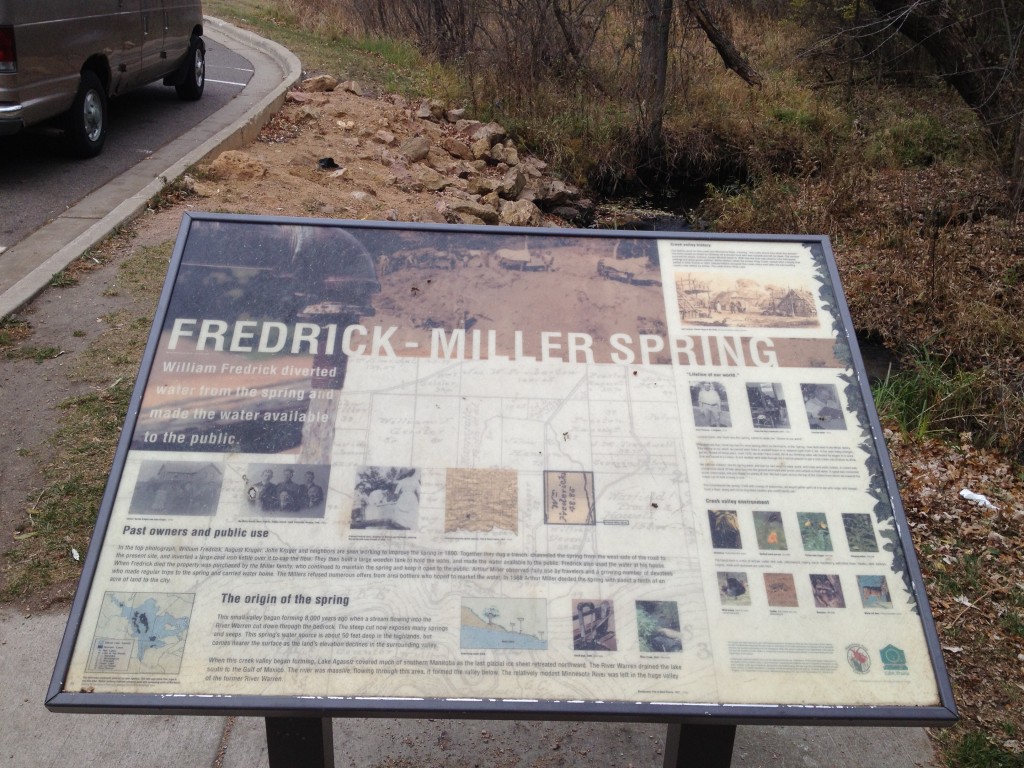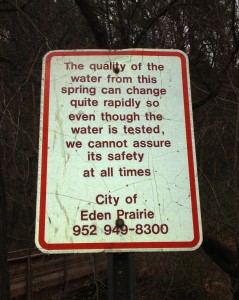
The Frederick Miller Spring has been a popular drinking water choice for those who want an alternative to drinking municipal “city” tap water.
One advantage to drinking tap water is that cities are legally required to provide ongoing water testing and drinking water quality reports. You may not like the results of the tests, but the information is there.
With spring water, you never really know what you’ll get – unless you have the water tested! For that reason, we collected several water samples and had them tested by two independent laboratories.
Here’s what we found:
Frederick Miller Spring Water Quality Test Results
Spring water is sometimes described as natural, or “living water”.
The term “living” implies that there are “things” growing and thriving in the water source (Plant life? Microbes? The Loch Ness Monster?). Microorganism testing is organism-specific, and conducted ala carte which can become very expensive.
Our testing was done pro bono.
While we did check for Arsenic (which can be a health risk), the water testing mainly focused on aesthetic issues. Here what the labs found from the samples we collected on 11/1/2011:
Alkalinity: 240ppm
Test results are similar to most of the well water that serves the municipalities and private residences in the west metro area.
Arsenic: 1ppb
The EPA health limit for this naturally occurring carcinogen is 0ppb, but you probably won’t find that in this part of town. 1ppb is not bad, and is actually lower than many of the western Minneapolis suburbs.
Hardness: 20gpg
Lots of dissolved rock here (Hard water comes from Calcite, Gypsum, and Dolomite). Very similar to Minnetonka and Chanhassen city water.
Iron: 0.01ppm
Rust stains begin at 0.3ppm, so we’re good to go here.
Manganese: 0.003ppm
Black stains become noticeable at 0.05ppm, and higher levels of Manganese have been shown to lower the IQ in children. This passes the test!
Nitrates: 2.0ppm
Legal limit is 10ppm, so this test passes. Nitrate contamination, which is believed to have come from a nearby landfill, has caused levels to exceed legal limits in the past.
pH: 7.51
No acidic issues here. High pH would be problematic if there was more iron in the water.
Phosphates: 0.08ppm
Nothing exciting here.
Saturation Index: +0.38
This is a corrosion indicator. A positive number indicates this would “leave deposits” as opposed to more aggressive water that would “dissolve” plumbing in an attempt to reach equilibrium (0.00).
Silica: 26.2ppm
Nothing exciting here either (wouldn’t be great for a boiler or cooling tower though).
TDS: 468ppm
Water started at as a rain drop made of Hydrogen and Oxygen (0ppm TDS). This is a measure of everything that dissolved into that drop of pure water. To get an accurate Total Dissolved Solids measurement, you really need an accurate TDS meter that compensates for temperature. The cheap handheld meters can be off by +/-25%. We like the meters from the Myron L company.
Summary

You now have a little more information about this water source to determine whether or not you’re comfortable drinking from it (or if it’s worth the gas money to go bottle up some water).
Would we drink it? Maybe if we were camping. In our homes? Probably not. Call us paranoid, but we get email updates about water contamination EVERY DAY! Today there are just too many toxic plumes for us to “consistently” trust an uncontrolled water source.
We’re also heavily biased as one of our primary services involves water purification for the medical and restaurant industries, in addition to homeowners.
About Premier Water
Premier Water is a local, family-owned water treatment company based in Chanhassen, MN. Since1978, Premier Water has successfully designed, installed, and serviced 1000’s of Water Purification and Water Filtration Systems.
We offer a FREE WATER TEST to gather information and help our clients get the right water treatment solution for their needs. We can also be reached at (952) 479-4553 for more information.
The Fredrick-Miller Spring is located on the east side of Spring Road (County Road 4) one-quarter mile north of US Highway 212/169.


Where can I find the most recent water quality test results and those going back about two years.
Gary
We just did those tests for fun. To my knowledge there is no regilar monitoring or testing of this spring.
You could contact the City of Eden Prairie to see if they have anything more recent.
This is an old thread, but I just found it. I live less than a mile from this spring.
The Minnesota Department of Health and the City of Eden Prairie do test the water quality for contaminates once a month. They still do not recommend drinking this water and caution people to do so only at their own risk because the conditions can change rapidly. In more than 30 years of testing the water monthly, it has never been found to be unsafe to drink. However, one nearby spill or field run off could change that quickly.
I’ve been drinking only this water from this spring since 1995. I usually fill about 12 gallons a week. no strange growths, clear skin, and just an overall feeling of health. thumbs up for this spring.
If you have been drinking from that spring, and still don’t have a tail, I’d say your good to go! 🙂
All kidding aside, thanks for sharing your experience. The water does test fairly well.
Thank you so much for this resource! I’m like you—a little paranoid about the constantly changing variables and their effect on the quality. We just happened upon this lovely place on a hike and I’m glad to hear that the water checks out (this time)! It seemed like a very popular spot. I filled up my little canteen and thought it tasted nice and minerally, but my dog wouldn’t drink it! (She drank the filtered water from home immediately after.) I trust her nose a bit more than mine, so at that point I got a little worried—but seeing your review made me feel much better. 😉
Good to hear! Thanks for posting. Great place to hike isn’t it?
This water is already tested for bad stuff. What would be interesting would be analysis of what GOOD minerals are in it. Essential nutrients in the water. That’s what I would like to know.
BTW, “living water” means that there is qi in the water. It has innate vitality of it’s own. It does not refer to ostensible “germs” or organisms in the water. lol
Thanks for posting!
What minerals are you looking for? Additional tests can be run for $15-50/test.
Thanks,
Lars